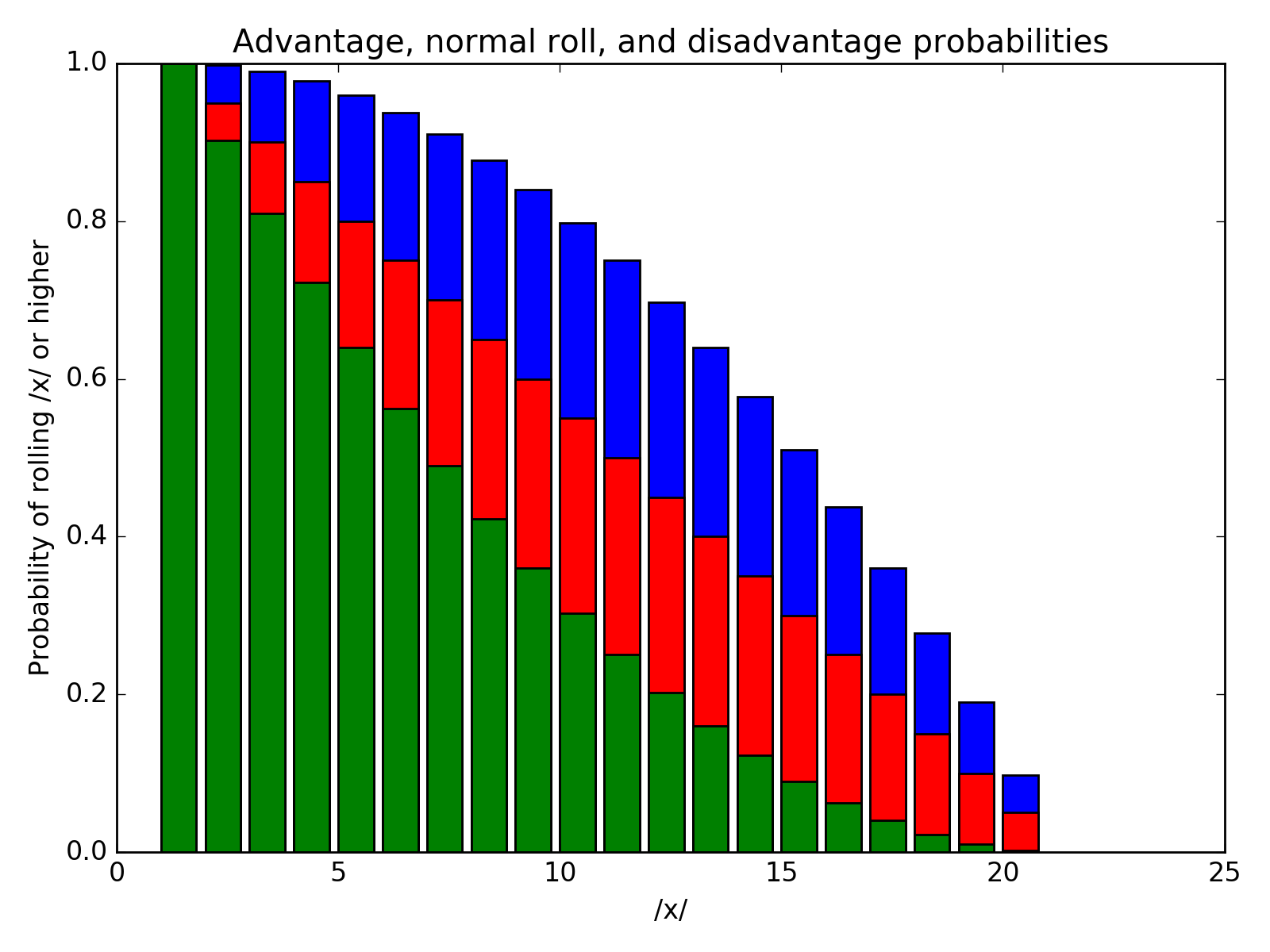D&D Probability distributions
Table of Contents
1 Dice averages
| D4 | D6 | D8 | D10 | D12 | D20 |
| 2.5 | 3.5 | 4.5 | 5.5 | 6.5 | 10.5 |
2 Advantage and Disadvantage
A normal, unweighted die has equal probabilities, so the cumulative probability distribution is just a straight line. However, the advantaged throws are much better, having
import numpy as np d20 = np.arange(1,21) disadvantage = (400-d20**2)/400.0 normal_roll = (20-d20)/20.0 advantage = ((20-d20)**2)/400.0 return np.array([d20.tolist(), disadvantage.tolist(), normal_roll.tolist(), advantage.tolist()]) \ .transpose()
| 1.0 | 0.9975 | 0.95 | 0.9025 |
| 2.0 | 0.99 | 0.9 | 0.81 |
| 3.0 | 0.9775 | 0.85 | 0.7225 |
| 4.0 | 0.96 | 0.8 | 0.64 |
| 5.0 | 0.9375 | 0.75 | 0.5625 |
| 6.0 | 0.91 | 0.7 | 0.49 |
| 7.0 | 0.8775 | 0.65 | 0.4225 |
| 8.0 | 0.84 | 0.6 | 0.36 |
| 9.0 | 0.7975 | 0.55 | 0.3025 |
| 10.0 | 0.75 | 0.5 | 0.25 |
| 11.0 | 0.6975 | 0.45 | 0.2025 |
| 12.0 | 0.64 | 0.4 | 0.16 |
| 13.0 | 0.5775 | 0.35 | 0.1225 |
| 14.0 | 0.51 | 0.3 | 0.09 |
| 15.0 | 0.4375 | 0.25 | 0.0625 |
| 16.0 | 0.36 | 0.2 | 0.04 |
| 17.0 | 0.2775 | 0.15 | 0.0225 |
| 18.0 | 0.19 | 0.1 | 0.01 |
| 19.0 | 0.0975 | 0.05 | 0.0025 |
| 20.0 | 0.0 | 0.0 | 0.0 |
import numpy as np import matplotlib.pyplot as plot rollsNP = np.array(rolls) fig, ax = plot.subplots() d20 = np.arange(1,21) ax.set_title("Advantage, normal roll, and disadvantage probabilities") ax.set_xlabel("/x/") ax.set_ylabel("Probability of rolling /x/ or higher") plot.bar(rollsNP.T[0], rollsNP.T[1], color='blue', label="disadvantage") plot.bar(rollsNP.T[0], rollsNP.T[2], color='red', label="normal roll") plot.bar(rollsNP.T[0], rollsNP.T[3], color='green', label="advantage") fig.tight_layout() name = 'adv-disadv-plot.png' fig.savefig(name, dpi=200) return name

3 Multiple rolls
Binomial distribution
| pmf | \({n \choose k}\,p^{k}(1-p)^{n-k}\) |
| CDF | \(\sum^{\lfloor k \rfloor}_{i=0} {n \choose i} p^i {(1-p)}^{n-i}\) |
| Mean | \(np\) |
| Median | \(\lfloor np\rfloor \text{ or } \lceil np\rceil\) |
| Mode | \(\lfloor (n+1)p\rfloor \text { or } \lceil (n+1)p\rceil -1\) |
| Variance | \(np(1-p)\) |
were \({n\choose k} = \frac{n!}{k!(n-k)!}\) is the binomial coefficient
(nCk on calculators), also known as choosing \(k\) subsets out of \(n\)
elements.